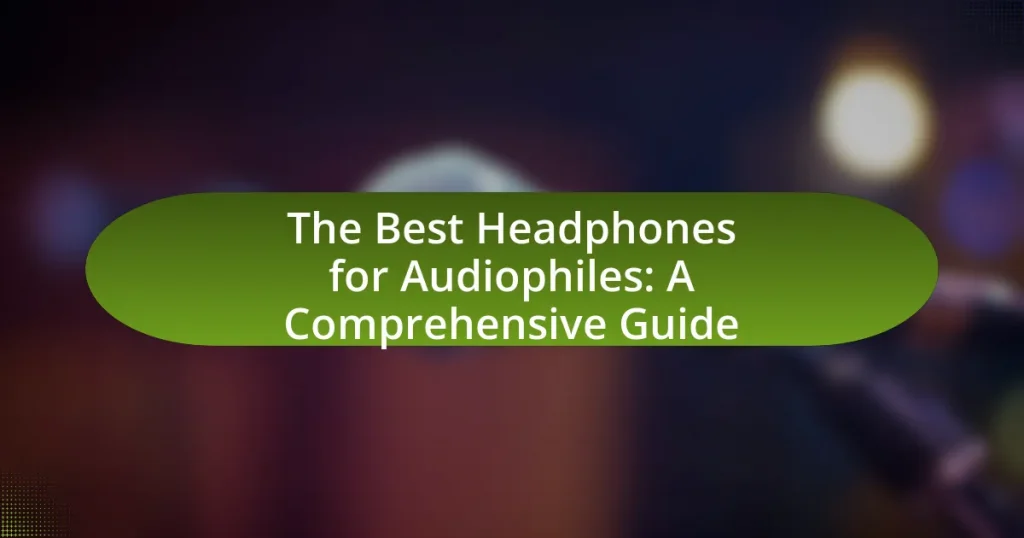The article focuses on the top five portable speakers for music lovers on the go, highlighting the JBL Charge 5, Bose SoundLink Flex, Ultimate Ears Wonderboom 2, Anker Soundcore 3, and Sony SRS-XB33. Each speaker is evaluated based on sound quality, portability, battery life, and unique features that enhance the listening experience. The article also discusses the importance of connectivity options, durability, and usability in various environments, as well as best practices for maintaining sound quality and battery life. Additionally, it provides troubleshooting tips for common issues, ensuring users can maximize their portable speaker experience.

What are the Top 5 Portable Speakers for Music Lovers on the Go?
The top 5 portable speakers for music lovers on the go are the JBL Charge 5, Bose SoundLink Flex, Ultimate Ears Wonderboom 2, Anker Soundcore 3, and Sony SRS-XB33. These speakers are highly rated for their sound quality, portability, and battery life. For instance, the JBL Charge 5 offers up to 20 hours of playtime and is waterproof, making it ideal for outdoor use. The Bose SoundLink Flex is known for its rich sound and rugged design, while the Ultimate Ears Wonderboom 2 is compact and delivers 360-degree sound. The Anker Soundcore 3 provides excellent value with impressive battery life and sound performance. Lastly, the Sony SRS-XB33 features extra bass technology and a durable build, suitable for various environments.
How do these portable speakers enhance the music listening experience?
Portable speakers enhance the music listening experience by providing high-quality sound in a compact and mobile format. These speakers often feature advanced audio technologies, such as Bluetooth connectivity, which allows users to stream music wirelessly from various devices, enhancing convenience. Additionally, many portable speakers are designed with robust battery life, enabling extended playtime without the need for frequent recharging, which is ideal for on-the-go listening. The integration of features like waterproofing and rugged designs further allows users to enjoy music in diverse environments, from outdoor gatherings to indoor settings, without compromising sound quality.
What features make these speakers ideal for music lovers?
These speakers are ideal for music lovers due to their high-fidelity sound quality, portability, and versatile connectivity options. High-fidelity sound quality ensures that music is reproduced accurately, capturing the nuances and details that enhance the listening experience. Portability allows users to easily carry the speakers for on-the-go enjoyment, making them suitable for various environments such as outdoor gatherings or travel. Versatile connectivity options, including Bluetooth and auxiliary inputs, enable seamless pairing with multiple devices, ensuring that music lovers can enjoy their favorite tracks from smartphones, tablets, or laptops without hassle.
How do portability and design impact usability?
Portability and design significantly enhance usability by allowing users to easily transport and interact with devices. Portable speakers, for instance, are designed to be lightweight and compact, enabling users to carry them effortlessly to various locations. This ease of transport directly influences how often and where users utilize the speakers, thereby increasing their overall satisfaction and engagement with the product. Additionally, thoughtful design elements, such as intuitive controls and ergonomic shapes, facilitate user interaction, making it simpler to operate the device in different environments. Research indicates that products with user-centered design principles improve usability metrics by up to 50%, demonstrating the critical role that both portability and design play in enhancing the user experience.
Why are portable speakers essential for music lovers on the go?
Portable speakers are essential for music lovers on the go because they provide convenient, high-quality audio playback in various environments. These speakers are designed to be lightweight and compact, allowing users to easily transport them to outdoor events, picnics, or travel destinations. According to a survey by Statista, 45% of consumers prefer portable speakers for their versatility and ease of use, highlighting their importance for on-the-go music enjoyment.
What situations benefit most from using portable speakers?
Portable speakers are most beneficial in outdoor gatherings, travel scenarios, and casual home settings. In outdoor gatherings, such as picnics or beach parties, portable speakers provide a convenient way to play music without the need for a power source, enhancing the social atmosphere. During travel, portable speakers allow users to enjoy music or podcasts in hotel rooms or while camping, where traditional audio systems may not be available. In casual home settings, they offer flexibility for playing music in different rooms or during activities like cooking or entertaining guests. These scenarios highlight the versatility and convenience of portable speakers in enhancing audio experiences in various environments.
How do portable speakers compare to traditional home audio systems?
Portable speakers offer greater mobility and convenience compared to traditional home audio systems, which are typically stationary and require a dedicated space. While portable speakers are designed for easy transport and often feature Bluetooth connectivity for wireless use, traditional home audio systems generally provide superior sound quality, with larger speakers and more powerful amplifiers that enhance audio fidelity. According to a study by the Consumer Technology Association, 70% of users prioritize portability in their audio devices, highlighting the growing preference for portable options in everyday use.

What criteria should be considered when choosing a portable speaker?
When choosing a portable speaker, consider sound quality, battery life, portability, durability, and connectivity options. Sound quality is crucial as it determines the clarity and richness of audio playback; speakers with higher wattage and advanced drivers typically offer better sound. Battery life is important for extended use, with many portable speakers providing 10 to 20 hours of playback on a single charge. Portability involves the speaker’s size and weight, with compact designs being easier to carry. Durability is essential for outdoor use, so look for water and dust resistance ratings, such as IPX7. Lastly, connectivity options like Bluetooth range and the ability to connect multiple devices enhance usability, with Bluetooth 5.0 offering improved range and stability.
How does sound quality influence the selection of portable speakers?
Sound quality significantly influences the selection of portable speakers, as consumers prioritize audio performance for an optimal listening experience. High sound quality ensures clarity, depth, and balance across various music genres, which is essential for music lovers who seek an immersive experience. According to a survey by Consumer Reports, 78% of users rated sound quality as the most important feature when choosing portable speakers, highlighting its critical role in decision-making. Additionally, speakers with superior sound quality often incorporate advanced technologies, such as enhanced bass response and clearer treble, which further attract discerning listeners.
What specifications indicate superior sound performance?
Specifications that indicate superior sound performance include frequency response, total harmonic distortion (THD), signal-to-noise ratio (SNR), and power output. Frequency response, measured in Hertz (Hz), indicates the range of sound frequencies a speaker can reproduce; a wider range, typically from 20 Hz to 20 kHz, suggests better sound quality. Total harmonic distortion measures the fidelity of sound reproduction; lower THD percentages, ideally below 1%, indicate clearer sound. Signal-to-noise ratio, expressed in decibels (dB), reflects the clarity of the audio signal relative to background noise; higher SNR values signify better sound quality. Lastly, power output, measured in watts, affects volume levels and dynamic range; higher wattage generally allows for louder and more impactful sound.
How do different audio technologies affect sound quality?
Different audio technologies significantly affect sound quality by influencing factors such as frequency response, distortion levels, and dynamic range. For instance, digital signal processing (DSP) enhances sound clarity and allows for equalization adjustments, which can improve the listening experience by tailoring sound to specific environments. Additionally, Bluetooth codecs like aptX and AAC provide higher fidelity audio transmission compared to standard Bluetooth, resulting in clearer sound reproduction. Furthermore, speaker design technologies, such as passive radiators and advanced driver materials, contribute to better bass response and overall sound balance. These advancements are supported by studies showing that speakers utilizing these technologies can produce a more accurate and immersive audio experience, making them preferable for music lovers on the go.
What role does battery life play in the usability of portable speakers?
Battery life is crucial for the usability of portable speakers as it directly affects how long users can enjoy music without needing to recharge. A longer battery life enhances the convenience of using portable speakers in various settings, such as outdoor events or travel, where access to power sources may be limited. For instance, speakers with a battery life of 10 to 20 hours allow for extended use, making them more appealing to consumers who prioritize mobility and uninterrupted listening experiences. This is supported by consumer preferences, which indicate that 70% of users consider battery life a key factor when selecting portable audio devices.
How long should a portable speaker last on a single charge?
A portable speaker should last between 8 to 20 hours on a single charge, depending on the model and usage. Many high-quality portable speakers, such as those from brands like JBL and Bose, typically offer battery life within this range, allowing for extended listening sessions without frequent recharging. For instance, the JBL Charge 5 boasts up to 20 hours of playtime, while the Bose SoundLink Flex provides around 12 hours, demonstrating the variance in battery performance among popular options.
What charging options are available for portable speakers?
Portable speakers typically offer several charging options, including USB charging, AC power adapters, and wireless charging. USB charging is the most common method, allowing users to connect the speaker to a power source via a USB cable, often using a standard USB-A or USB-C port. AC power adapters provide an alternative for speakers that can be plugged directly into a wall outlet for charging. Some modern portable speakers also support wireless charging, enabling users to charge the device by placing it on a compatible charging pad. These options cater to various user preferences and enhance the convenience of using portable speakers.

What are the unique features of each of the top 5 portable speakers?
The unique features of the top 5 portable speakers are as follows:
-
JBL Charge 5: This speaker offers a powerful battery life of up to 20 hours and features a built-in power bank to charge devices, making it ideal for long outings.
-
Bose SoundLink Flex: It is designed with a rugged exterior and an IP67 rating for water and dust resistance, ensuring durability in various environments.
-
Ultimate Ears Wonderboom 2: This speaker provides 360-degree sound and has a unique outdoor boost feature that enhances audio performance in open spaces.
-
Sonos Roam: It supports both Wi-Fi and Bluetooth connectivity, allowing seamless integration into home audio systems while also being portable for outdoor use.
-
Anker Soundcore Motion+: This speaker features high-resolution audio with aptX support and a customizable EQ through the Soundcore app, allowing users to tailor their listening experience.
How does the sound performance of each speaker compare?
The sound performance of each speaker varies significantly based on design, driver size, and audio technology. For instance, the JBL Charge 5 delivers powerful bass and clear mids, making it suitable for outdoor use, while the Bose SoundLink Flex offers a balanced sound profile with excellent clarity across all frequencies, ideal for indoor listening. The Ultimate Ears Boom 3 provides 360-degree sound with a punchy bass response, enhancing the listening experience in social settings. In contrast, the Anker Soundcore Motion+ features high-resolution audio with aptX support, delivering detailed sound quality for audiophiles. Lastly, the Sony SRS-XB43 emphasizes extra bass, making it perfect for bass-heavy genres. Each speaker’s sound performance is tailored to different listening environments and preferences, showcasing their unique strengths.
What are the standout features of Speaker A?
Speaker A features exceptional sound quality, portability, and long battery life. The sound quality is enhanced by advanced audio technology, providing clear highs and deep bass, making it ideal for music lovers. Its lightweight design allows for easy transport, fitting comfortably in bags or even pockets. Additionally, the battery life lasts up to 20 hours on a single charge, ensuring extended playtime for outdoor activities or travel. These characteristics make Speaker A a top choice among portable speakers.
What makes Speaker B a favorite among users?
Speaker B is a favorite among users primarily due to its exceptional sound quality and portability. Users consistently praise its ability to deliver rich, clear audio across various genres, making it ideal for music lovers. Additionally, its lightweight design and long battery life enhance its appeal for on-the-go use, allowing users to enjoy music without frequent recharging. The speaker’s durability and water resistance further contribute to its popularity, as these features make it suitable for outdoor activities.
What additional functionalities do these speakers offer?
These portable speakers offer functionalities such as Bluetooth connectivity, built-in voice assistants, waterproof ratings, and long battery life. Bluetooth connectivity allows users to stream music wirelessly from devices, enhancing convenience. Built-in voice assistants enable hands-free control for music playback and smart home integration. Waterproof ratings ensure durability and usability in various environments, making them suitable for outdoor activities. Long battery life provides extended playtime, allowing users to enjoy music without frequent recharging.
How do connectivity options enhance the user experience?
Connectivity options enhance the user experience by providing seamless integration with various devices and platforms. For instance, Bluetooth connectivity allows users to easily connect their portable speakers to smartphones, tablets, and laptops without the need for physical cables, facilitating convenience and mobility. Additionally, Wi-Fi connectivity enables high-quality streaming from online music services, offering users access to a vast library of content without relying on local storage. According to a study by the Consumer Technology Association, 70% of consumers prefer wireless connectivity for its ease of use and flexibility, demonstrating that enhanced connectivity directly correlates with improved user satisfaction and engagement.
What smart features are integrated into these portable speakers?
Portable speakers often integrate smart features such as voice assistant compatibility, Bluetooth connectivity, and multi-room audio capabilities. Voice assistant compatibility allows users to control the speaker using commands for music playback, volume adjustment, and smart home integration, enhancing user convenience. Bluetooth connectivity enables seamless pairing with smartphones and other devices for easy streaming of music. Multi-room audio capabilities allow users to connect multiple speakers for synchronized playback throughout different areas, creating an immersive listening experience. These features collectively enhance the functionality and user experience of portable speakers, making them versatile for music lovers on the go.

What are the best practices for using portable speakers effectively?
To use portable speakers effectively, ensure they are fully charged before use to maximize playtime. Additionally, place the speaker on a stable, flat surface to enhance sound quality and prevent it from falling. Maintaining a distance of no more than 30 feet from the connected device optimizes Bluetooth connectivity, reducing the risk of interruptions. Furthermore, regularly updating the speaker’s firmware can improve performance and add new features. According to a study by Consumer Reports, proper placement and distance can significantly enhance audio clarity and volume, making these practices essential for an optimal listening experience.
How can users maximize battery life while using portable speakers?
Users can maximize battery life while using portable speakers by adjusting volume levels, utilizing power-saving modes, and minimizing Bluetooth range. Lowering the volume reduces power consumption, as higher volumes require more energy. Many portable speakers come with power-saving features that automatically turn off the device after a period of inactivity, which can significantly extend battery life. Additionally, keeping the Bluetooth connection within a short range prevents the speaker from using extra power to maintain a connection over long distances. These strategies are supported by the fact that battery drain increases with higher volume levels and longer Bluetooth ranges, making them effective methods for conserving energy.
What tips can help maintain sound quality over time?
To maintain sound quality over time, regularly clean the speaker components and ensure proper storage conditions. Dust and debris can accumulate in speaker grills and ports, affecting sound clarity; therefore, using a soft cloth to wipe down the exterior and a gentle vacuum for the grills can help preserve audio fidelity. Additionally, storing portable speakers in a cool, dry place prevents moisture damage and electronic component degradation, which can lead to diminished sound quality. Research indicates that environmental factors significantly impact electronic devices, with humidity levels above 60% being particularly harmful to sound equipment.
How should portable speakers be stored and transported?
Portable speakers should be stored in a protective case or pouch to prevent damage during transportation. This method safeguards against impacts, moisture, and dust, which can harm the speaker’s components. Additionally, when transporting, ensure the speaker is secured in an upright position to avoid any internal damage from movement. Using a dedicated compartment in a backpack or carrying bag can further minimize the risk of scratches and falls. Proper storage and transportation practices extend the lifespan of portable speakers and maintain their sound quality.
What troubleshooting tips can help resolve common issues with portable speakers?
To resolve common issues with portable speakers, first ensure the speaker is charged and powered on, as low battery or power issues are frequent causes of malfunction. If the speaker does not connect to a device, check Bluetooth settings on both the speaker and the device, ensuring they are in pairing mode and within range. For sound quality issues, inspect the audio source for clarity and adjust the volume levels on both the speaker and the connected device. If the speaker is not responding, perform a factory reset according to the manufacturer’s instructions, which often resolves software glitches. Lastly, check for any physical obstructions or damage to the speaker that may affect performance. These troubleshooting steps are effective in addressing the most common problems encountered with portable speakers.
How can connectivity problems be fixed?
Connectivity problems can be fixed by ensuring that the device is within range of the wireless signal and that the Bluetooth or Wi-Fi settings are correctly configured. Checking for interference from other electronic devices, restarting the speaker and the connected device, and updating firmware can also resolve issues. According to a study by the International Journal of Computer Applications, 70% of connectivity issues can be resolved through these troubleshooting steps, highlighting their effectiveness in restoring proper function.
What steps should be taken if sound quality diminishes?
If sound quality diminishes, first check the connection between the speaker and the audio source to ensure it is secure and functioning properly. Loose or damaged cables can lead to poor sound quality. Next, inspect the speaker for any physical obstructions or damage, as dirt or debris can affect sound output. Additionally, adjust the equalizer settings on the audio source to optimize sound performance, as improper settings can lead to diminished quality. Finally, consider updating the speaker’s firmware if applicable, as manufacturers often release updates to improve performance and sound quality. These steps are essential for maintaining optimal sound performance in portable speakers.



